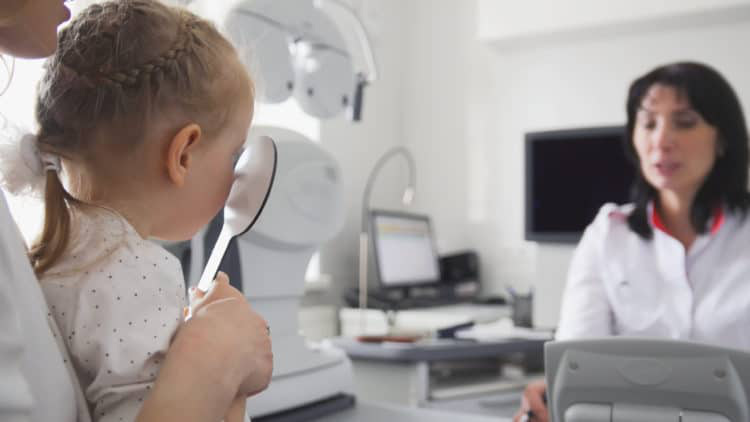
Strabismus is common in young children and if not treated early can lead to amblyopia - Illustration photo
Dr. Vu Thi Que Anh, Department of Ophthalmology, Hanoi Medical University Hospital, said that strabismus (also known as squint) is a phenomenon in which the two eyes do not have the same axis of vision. One eye can turn inward, outward, up, down, while the other eye looks straight.
When one eye turns inward, the patient has introversion. When one eye turns outward, the patient has extroversion. When the eyes are not aligned, the images sent to the brain from each eye are too different to be able to combine the two images into one.
"If strabismus is not treated, the brain may begin to reject images from the eye that is in a different direction from the main axis of vision. This leads to a decrease in vision, also known as amblyopia," Dr. Que Anh emphasized.
According to doctors, there are many different types of strabismus. Usually, strabismus is divided according to the direction of the strabismus. Common types of strabismus include internal strabismus, external strabismus, and vertical strabismus.
Strabismus can also be classified according to the cause:
- 3 of the 12 cranial nerves (III, IV, VI) are involved in innervating the ocular muscles and paralysis of these nerves can cause strabismus.
- Due to trauma, vascular diseases such as stroke, or thyroid disease...
- Some special strabismus disorders may have their own names such as Brown syndrome, Duane syndrome, Ciancia syndrome...
Can strabismus be treated?
Dr. Que Anh added that strabismus is common in young children and if strabismus is not treated early, it can lead to amblyopia due to strabismus.
Currently, strabismus treatment includes surgical and non-surgical methods to correct misalignment of the eyeball.
Non-surgical treatments
Glasses or contact lenses: Improve vision and treat accommodation-induced strabismus.
Using prisms: this is a special type of lens used to treat strabismus. The prism has a thick base and a thinner top, and depending on the direction of the strabismus, the base of the prism is adjusted to point outward or inward.
Glasses help to direct light into the eye and reduce the deviation of the eye axis when looking at a target object.
Vision exercises: Your ophthalmologist will instruct you in vision exercises to improve and correct your binocular coordination. Your eyes will be trained to stimulate brain activity, by forcing your eyes to respond to signals from the brain and vice versa.
Surgical treatments
Depending on the degree of strabismus, binocular vision, strabismus morphology, and muscle movement, the surgeon may prescribe different methods such as muscle regression, muscle regression with suture correction, muscle retraction, or muscle relocation to achieve appropriate correction.
The goal of strabismus treatment is to bring the eyes into alignment; improve binocular vision as much as possible; help the eyes work together (maintain binocular vision); and improve aesthetics.
Preventing strabismus
Eye experts say that to prevent strabismus, you can keep in mind the following:
- For children in the growing stage, regular eye exams should be performed so that the doctor can check for abnormalities.
- People with injuries involving the head and eyes should also be examined.
- For families with members who have had strabismus or impaired vision, children should have their eyes examined early and be regularly monitored for any unusual eye symptoms.
- People with refractive errors or brain damage, diabetes, or stroke can be monitored and examined more frequently.
- Increase foods that can provide vitamins A, B, C, omega 3 such as: salmon, bell peppers, sweet potatoes, carrots, poultry... to keep eyes healthy.
For those who have contracted the disease and are undergoing treatment, it is necessary to strictly follow the doctor's instructions. In particular, it is necessary to pay attention to regular exercise to improve eyesight. Visit the doctor on schedule. The disease is not life-threatening, but you should not be subjective because early detection means a higher chance of cure.
 Children with strabismus increase sharply due to phone usage habits?
Children with strabismus increase sharply due to phone usage habits?Source: https://tuoitre.vn/co-chua-duoc-tinh-trang-lac-mat-khong-20241016221404476.htm

































































![[Photo] National Assembly Chairman Tran Thanh Man receives Chairman of Morocco-Vietnam Friendship Association](https://vphoto.vietnam.vn/thumb/402x226/vietnam/resource/IMAGE/2025/7/26/b5fb486562044db9a5e95efb6dc6a263)



































Comment (0)